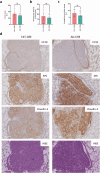TAT-CRE inhalation enables tumor induction corresponding to adenoviral Cre-recombinase in a lung cancer mouse model
- PMID: 40360735
- PMCID: PMC12075843
- DOI: 10.1038/s42003-025-08146-0
TAT-CRE inhalation enables tumor induction corresponding to adenoviral Cre-recombinase in a lung cancer mouse model
Abstract
Cre-recombinase inducible model systems are extensively used in cancer research to manipulate gene expression in specific tissues and induce autochthonous tumor growth. These systems often involve the cross-breeding of genetically engineered organisms containing loxP-flanked alleles with those expressing Cre-recombinase. This approach, while effective, has the challenge of requiring high numbers of animals due to breeding requirements. Other frequently used tumor induction methods in cancer research involve the direct application of viral Cre-recombinase vectors. This approach presents the challenge of the accessibility of facilities that meet the necessary safety level. In this context, we perform a comprehensive comparison between TAT-CRE (biosafety level S1) and adenoviral Cre-recombinase induced (biosafety level S2) lung adenocarcinomas driven by KrasG12D expression and Trp53 depletion. We use in vivo lung tumor monitoring via computed tomography, single-cell RNA sequencing, immunohistochemistry and flow cytometry to elucidate similarities and differences between TAT-CRE and adenoviral Cre-recombinase induced lung adenocarcinomas. TAT-CRE induced lung tumors present differences in micro-vessels and macrophages but with corresponding tumor onset and growth characteristics compared to adenoviral-Cre recombinase induced lung tumors. Taken together, TAT-CRE is a valuable genetic engineering safety level S1 alternative for cancer induction and may be implemented in other cancer models than lung cancer.
© 2025. The Author(s).
Conflict of interest statement
Competing interests: The authors declare no competing interests.
Figures







References
-
- Misawa, H. et al. Type selective ablation of postnatal slow and fast fatigue-resistant motor neurons in mice induces late onset kinetic and postural tremor following fiber-type transition and myopathy. Exp. Neurol.376, 114772 (2024). - PubMed
-
- Chen, Y. et al. Cancer-Associated Endocrine Cells Participate in Pancreatic Carcinogenesis. Gastroenterology10.1053/j.gastro.2024.07.016 (2024). - PubMed
-
- Sutherland, K. D. et al. Cell of origin of small cell lung cancer: inactivation of Trp53 and Rb1 in distinct cell types of adult mouse lung. Cancer Cell19, 754–764 (2011). - PubMed
MeSH terms
Substances
Grants and funding
- 70113307/Deutsche Krebshilfe (German Cancer Aid)
- 70113009/Deutsche Krebshilfe (German Cancer Aid)
- 10.21.1.026MN/Fritz Thyssen Stiftung (Fritz Thyssen Foundation)
- UL379/1-1/Deutsche Forschungsgemeinschaft (German Research Foundation)
- 455784452/Deutsche Forschungsgemeinschaft (German Research Foundation)
LinkOut - more resources
Full Text Sources
Medical
Molecular Biology Databases
Research Materials
Miscellaneous

